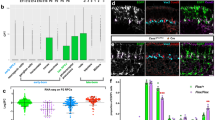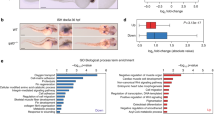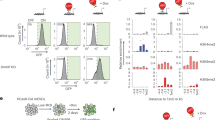Abstract
The neuron-restrictive silencer factor NRSF (also known as REST and XBR) can silence transcription from neuronal promoters in non-neuronal cell lines, but its function during normal development is unknown. In mice, a targeted mutation of Rest, the gene encoding NRSF, caused derepression of neuron-specific tubulin in a subset of non-neural tissues and embryonic lethality. Mosaic inhibition of NRSF in chicken embryos, using a dominant-negative form of NRSF, also caused derepression of neuronal tubulin, as well as of several other neuronal target genes, in both non-neural tissues and central nervous system neuronal progenitors. These results indicate that NRSF is required to repress neuronal gene expression in vivo, in both extra-neural and undifferentiated neural tissue.
This is a preview of subscription content, access via your institution
Access options
Subscribe to this journal
Receive 12 print issues and online access
$209.00 per year
only $17.42 per issue
Buy this article
- Purchase on Springer Link
- Instant access to full article PDF
Prices may be subject to local taxes which are calculated during checkout









Similar content being viewed by others
Accession codes
References
Arnone, M.I. & Davidson, E.H. The hardwiring of development—organization and function of genomic regulatory systems. Development 124, 1851–1864 (1997).
Gray, S. & Levine, M. Transcriptional repression in development . Curr. Opin. Cell. Biol. 8, 358– 364 (1996).
Mandel, G. & McKinnon, D. Molecular basis of neural-specific gene expression. Annu. Rev. Neurosci. 16, 323–345 (1993).
Schoenherr, C.J. & Anderson, D.J. Silencing is golden: negative regulation in the control of neuronal gene transcription . Curr. Opin. Neurobiol. 5, 566– 571 (1995).
Mori, N., Schoenherr, C., Vandenbergh, D.J. & Anderson, D.J. A common silencer element in the SCG10 and type II Na+ channel genes binds a factor present in nonneuronal cells but not in neuronal cells . Neuron 9, 45–54 (1992).
Kraner, S.D., Chong, J.A., Tsay, H.J. & Mandel, G. Silencing the type II sodium channel gene: a model for neural-specific gene regulation. Neuron 9, 37–44 ( 1992).
Schoenherr, C.J., Paquette, A.J. & Anderson, D.J. Identification of potential target genes for the neuron-restrictive silencer factor. Proc. Natl Acad. Sci. USA 93, 9881–9886 (1996).
Scholl, T., Stevens, M.B., Mahanta, S. & Strominger, J.L. A zinc finger protein that represses transcription of the human MHC class II gene, DPA. J. Immunol. 156, 1448– 1457 (1996).
Schoenherr, C.J. & Anderson, D.J. The neuron-restrictive silencer factor (NRSF): A coordinate repressor of multiple neuron-specific genes. Science 267, 1360– 1363 (1995).
Chong, J.A. et al. REST: A mammalian silencer protein that restricts sodium channel expression to neurons. Cell 80, 949– 957 (1995).
Wuenschell, C.W., Mori, N. & Anderson, D.J. Analysis of SCG10 gene expression in transgenic mice reveals that neural specificity is achieved through selective derepression . Neuron 4, 595–602 (1990).
Bessis, A., Champtiaux, N., Chatelin, L. & Changeux, J.-P. The neuron-restrictive silencer element: a dual enhancer/silencer crucial for patterned expression of a nicotinic receptor gene in the brain. Proc. Natl Acad. Sci. USA 94, 5906– 5911 (1997).
Kallunki, P., Edelman, G.M. & Jones, F.S. Tissue-specific expression of the L1 cell adhesion molecular is modulated by the neural restrictive silencer element. J. Cell. Biol. 138, 1343–1354 (1997).
Kallunki, P., Jenkinson, S., Edelman, G.M. & Jones, F.S. Silencer elements modulate the expression of the gene for the neuron-glia cell-adhesion molecule, NG-CAM. J. Biol. Chem. 270, 21291–21298 (1995).
Li, L., Suzuki, T., Mori, N. & Greengard, P. Identification of a functional silencer element involved in neuron-specific expression of the synapsin I gene. Proc. Natl Acad. Sci. USA 90, 1460–1464 (1993).
Schoch, S., Cibelli, G. & Thiel, G. Neuron-specific gene expression of synapsin I: major role of a negative regulatory mechanism. J. Biol. Chem. 271, 3317–3323 (1996).
Moody, S.A., Quigg, M.S. & Frankfurter, A. Development of the peripheral trigeminal system in the chick revealed by an isotype-specific anti-ß-tubulin monoclonal antibody . J. Comp. Neurol. 279, 567– 580 (1989).
Molkentin, J.D. & Olson, E.N. Defining the regulatory networks for muscle development. Curr. Opin. Genet. Dev. 6, 445–453 (1996).
Tapia-Ramirez, J., Eggen, B.J.L., Peral-Rubio, M.J., Toledo-Aral, J.J. & Mandel, G. A single zinc finger motif in the silencing factor REST represses the neural-specific type II sodium channel promoter. Proc. Natl Acad. Sci. USA 94, 1177–1182 (1997).
Fekete, D.M. & Cepko, C.L. Replication-competent retroviral vectors encoding alkaline phosphatase reveal spatial restriction of viral gene expression/transduction in the chick embryo. 13, 2604–2613 (1993).
Homburger, S.A. & Fekete, D.M. High efficiency gene transfer into the embryonic chicken CNS using B-subgroup retroviruses . Dev. Dyn. 206, 112–120 (1996).
Petropoulos, C.J. & Hughes, S.H. Replication-competent retrovirus vectors for the transfer and expression of gene cassettes in avian cells. J. Virol. 65, 3728– 3737 (1991).
Bader, D., Masaki, T. & Fischmann, D.A. Immuno-chemical analysis of myosin heavy chain during avian myogenesis in vivo and in vitro. J. Cell. Biol. 95, 763–770 ( 1982).
Kallunki, P., Edelman, G.M. & Jones, F.S. The neural restrictive silencer element can act as both a repressor and enhancer of L1 cell adhesion molecule gene expression during postnatal development. Proc. Natl Acad. Sci. USA in press.
Palm, K., Belluardo, N., Metsis, M. & Timmusk, T. Neuronal expression of zinc-finger transcription factor REST/NRSF/XBR gene . J. Neurosci. 18, 1280– 1296 (1998).
Vandenbergh, D.J., Wuenschell, C.W., Mori, N. & Anderson, D.J. Chromatin structure as a molecular marker of cell lineage and developmental potential in neural crest-derived chromaffin cells. Neuron 3, 507–518 (1989).
Kohler, J., Schafer-Preuss, S. & Buttgereit, D. Related enhancers in the intron of the beta1 tubulin gene of Drosophila melanogaster are essential for maternal and CNS-specific expression during embryogenesis. Nucleic Acids Res. 24, 2543–2550 (1996).
Robertson, E.J. Embryo-derived stem cell lines. in Teratocarcinomas and Embryonic Stem Cells: A Practical Approach (ed. Robertson, E.J.) 71– 112 (IRL Press, Oxford, 1987).
Hunter, E. Biological techniques for avian sarcoma viruses. Methods Enzymol. 58, 379–393 ( 1979).
Morgan, B.A. & Fekete, D.M. Manipulating gene expression with replication-competent retroviruses. in Methods in Avian Embryology (ed. Bronner-Fraser, M.E.) 185–218 (Academic Press, San Diego, 1996).
Hamburger, V. & Hamilton, H.L. A series of normal stages in the development of the chick embryo. Dev. Dyn. 195, PPL>272 (1992).
Kaufman, M.H. Histological procedures for mammalian embryos. in Postimplantation Mammalian Embryos, A Practical Approach (eds Copp, A.J. & Cockroft, D.L.) 81–91 (IRL Press, Oxford, UK, 1990).
Ma, Q., Chen, Z.F., Barrantes, I.B., de la Pompa, J.L. & Anderson, D.J. Neurogenin 1 is essential for the determination of neuronal precursors for proximal cranial sensory ganglia. Neuron 20, 469– 482 (1998).
Birren, S.J., Lo, L.C. & Anderson, D.J. Sympathetic neurons undergo a developmental switch in trophic dependence. Development 119, 597–610 (1993).
Myat, A., Henrique, D., Ish-Horowicz, D. & Lewis, J. A chick homologue of Serrate, and its relationship with Notch and Delta homologues during central neurogenesis. Dev. Biol. 174, 233–247 ( 1996).
Strahle, U., Blader, P., Adam, J. & Ingham, P. A simple and efficient procedure for non-isotopic in situ hybridization to sectioned material . Trends Genet. 10, 75– 76 (1994).
Acknowledgements
We thank R. Behringer and A. Bradley for AB-1 ES cells, SNL 76/7STO cells and FIAU, G. Friedrich for a mouse 129 Sv/Ev genomic library, S.L. Zipursky and B. Wold for helpful discussions and P. Sternberg, K. Zinn, E. Meyerowitz and E. Davidson for their comments on the manuscript. We thank P. Lonnerberg for Ng-CAM cDNA, P. White for help generating CEFs, B. Martinsen and C. Marcelle for advice on RCAS concentration, Shirley Pease, Arti Gaur and members of the TAFCIT staff for expert assistance with chimaera production and mouse maintenance, S. Ou and L. Wang for help with monoclonal antibody production and S. Padilla for technical assistance. This work was supported by a grant from the NIH. A.J.P. is supported by an NIH pre-doctoral training grant. Z.F.C. is an Associate and D.J.A. an Investigator of the Howard Hughes Medical Institute.
Author information
Authors and Affiliations
Corresponding author
Rights and permissions
About this article
Cite this article
Chen, ZF., Paquette, A. & Anderson, D. NRSF/REST is required in vivo for repression of multiple neuronal target genes during embryogenesis. Nat Genet 20, 136–142 (1998). https://doi.org/10.1038/2431
Received:
Accepted:
Issue Date:
DOI: https://doi.org/10.1038/2431
This article is cited by
-
Analysis of REST binding sites with canonical and non-canonical motifs in human cell lines
BMC Medical Genomics (2024)
-
The cause of Jones syndrome put to REST: a mutation in the REST gene causes gingival fibromatosis and hearing loss
European Journal of Human Genetics (2023)
-
Integrated multiomics analysis of chromosome 19 miRNA cluster in bladder cancer
Functional & Integrative Genomics (2023)
-
REST in the Road Map of Brain Development
Cellular and Molecular Neurobiology (2023)
-
Mammalian SWI/SNF continuously restores local accessibility to chromatin
Nature Genetics (2021)



